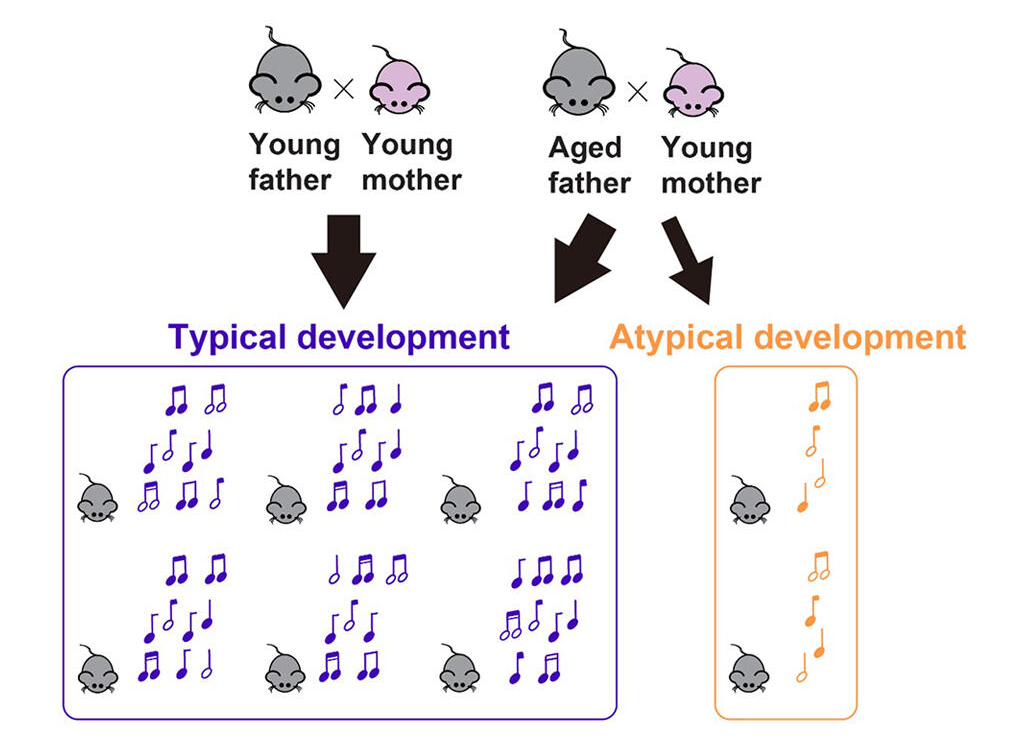Crying in human newborns is an innate form of communication, and while variations in crying exist from child to child, characteristic abnormalities have been observed in certain neurodevelopmental disorders. On the other hand, when newborn mice are separated from their mothers or littermates, they also attract their mothers' attention with ultrasonic vocalizations. Ultrasonic vocalizations in newborn pups function as social signals for vocal communication and could be used as a model for crying in human newborns.
Autism spectrum disorder is a type of neurodevelopmental disorder characterized by abnormal social communication and emotional behavior. It has been repeatedly reported that aging fathers are a risk factor for autism spectrum disorders and other disorders in their children.
A research group led by Professor Noriko Osumi and her colleagues in the Department of Developmental Neuroscience, Graduate School of Medicine, Tohoku University, reported in 2020 that the protein REST/NRSF, which regulates neural differentiation, is involved in the molecular pathogenetic basis for the development of neurodevelopmental disorders in children from older fathers, and that non-genetic factors (epigenetic variation) in sperm have trans-generational effects.
In this study, the research group conducted a detailed analysis of the effects of paternal aging on the early development of vocal communication in mice using a machine learning-based classification method and found that the number and duration of ultrasonic vocalizations in pups born to aging fathers decreased and changes in the pattern of vocalizations were observed. In addition, they found that many "atypical" individuals deviated from the typical speech developmental pathway in the pups born from aging fathers. This is the first report to identify the impact of paternal aging on the development of early speech communication in the next generation and was published in the electronic edition of iScience.
When a pup is separated from its mother, it tries to attract the mother by crying with an ultrasonic vocalization. In the experiment, it was observed that the number and duration of ultrasonic vocalizations was lower in pups from advanced age fathers compared to pups derived from young fathers. Changes from 3 to 12 days of age also revealed that pups from aged fathers had a delayed diversification of ultrasonic vocalization emittance patterns compared to pups from younger fathers. Further principal component analysis in conjunction with clustering analysis of the developmental patterns of each individual showed that pups born to young fathers had similar, or converging, population characteristics during postnatal development, whereas those born to advanced age fathers remained highly diverse.

Provided by Tohoku University
The study found that pups born to young fathers develop stereotyped speech development with a rich speech repertoire during postnatal development, whereas those born to advanced age fathers develop atypical speech development with a small repertoire.
"The increase in developmental disabilities is a social issue, but from the larger perspective of evolution, the role that aging fathers play is not necessarily a bad thing," explains Professor Osumi. "Since the egg is a large cell and is responsible for a significant part of the inheritance of life, the imparting of diversity from the sperm may be a major point of evolution."
In Japan, the aging population, in particular the declining birthrate, has become a major social problem, with the number of births in 2009 falling to 811,604 and the total fertility rate to 1.3. However, neurodevelopmental disorders are on the rise, and the number of students in special-needs classes has doubled over the past 10 years (to about 250,000).
"In order to have healthy children, I think it is important to consider aging, not only on the mother's side, but on the father's side as well." says Professor Osumi.
This article has been translated by JST with permission from The Science News Ltd.(https://sci-news.co.jp/). Unauthorized reproduction of the article and photographs is prohibited.




